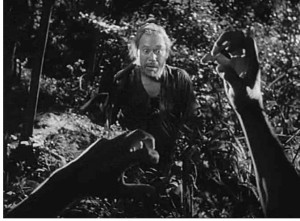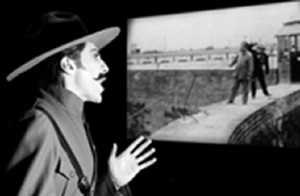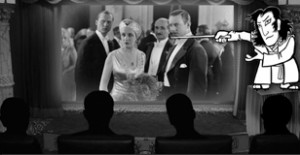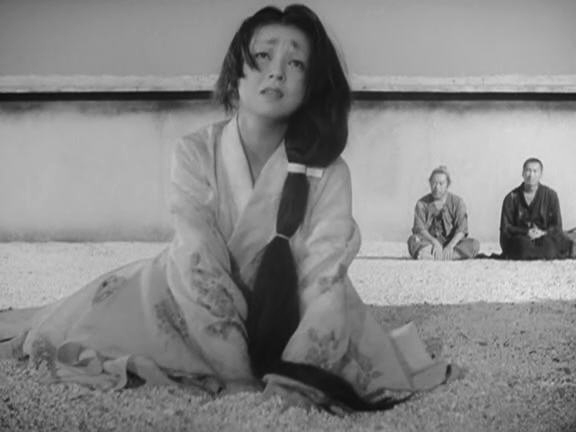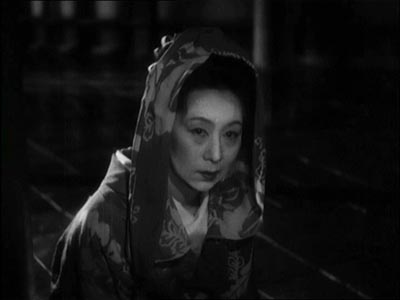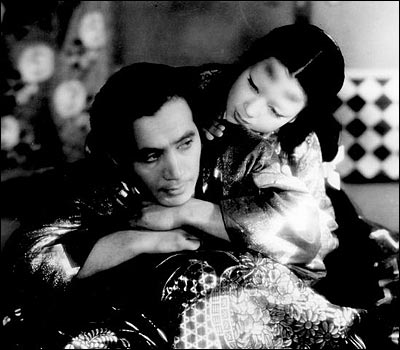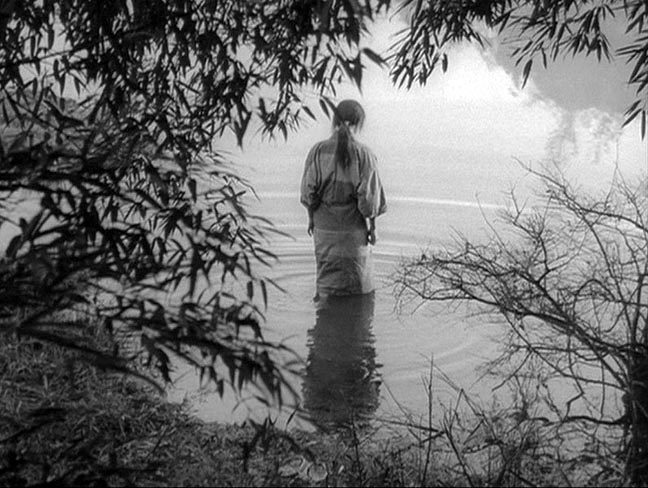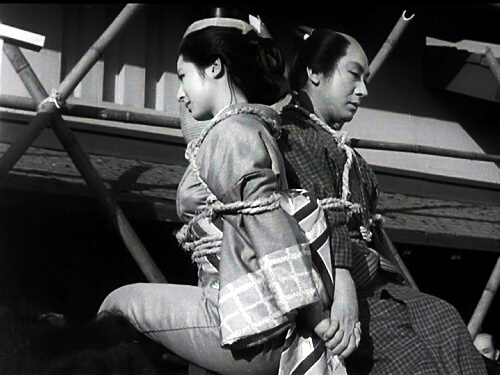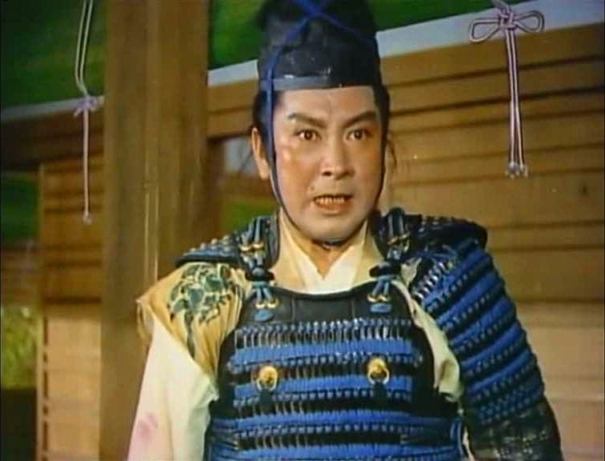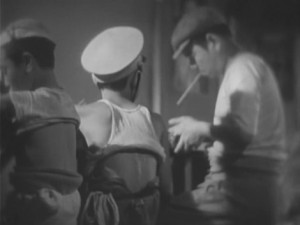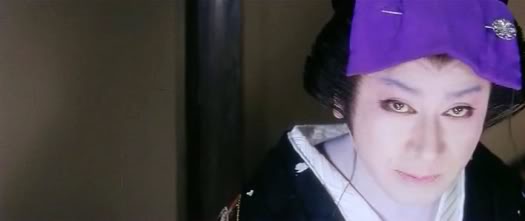From Movies of the Fifties, edited by Ann Lloyd (London: Orbis Publishing, 1982). Prior to this, it was published in one of the “chapters” of The Movie in 1981 or 1982, but I’m no longer clear about which one. — J.R.
For two centuries, Japan chose to isolate itself from the rest of the world. Then, in 1894, the American Commodore Perry sailed into Tokyo Bay and ‘rediscovered’ the Japanese islands. Yet nothing was known about Japanese cinema in the West for almost another century. The difference was that whereas Perry had come upon a country that appeared technologically backward, the west encountered a cinema that was, on the evidence of the films that began to be shown in the Fifties, every bit as advanced as its own.
By and large western recognition and appreciation of Japanese films can be said to have dated from the appearance of key movies at the Venice and Cannes Film Festivals.Akira Kurosawa’s Rashomon (1950) won the Golden Lion at Venice in 1951 and the same honor was bestowed upon four films by Kenji Mizoguchi in the succeeding years. The films were: Saikaku Ichidai Onna (1952, The Life of Oharu),Ugetsu Monogatari (1953, Tales of the Pale and Silvery Moon After the Rain), Sansho Dayu (1954, Sansho the Bailiff ) and Yokihi (1955, The Empress Yang Kwei-Fei). By the time that Teinosuke Kinugasa’s Jogokumon (1953, Gate of Hell) was awarded the Cannes Film Festival’s Golden Palm, Japanese cinema had clearly become a cultural force to be reckoned with.
Why did it take so long for the west to acknowledge the depth and sophistication of a national cinema that had already been undergoing steady developments for half a century? Part of the answer lies in the geographical and cultural insularity of the country itself — a tendency that was most pronounced during the late Thirties and in the course of World War II. This compounded the attitude that there was little to interest Westerners in Japanese culture anyway. One recent western commentator on Japanese cinema, the critic Noël Burch, has argued that the ‘golden age’ of Japanese film was precisely the period when the country was most closed to outside influences and therefore able to pursue its own concerns in relative isolation from the cultural values of Hollywood and Europe.
This raises yet another reason for the long-term remoteness. of Japanese cinema: what might be called an alternative set of traditions and conventions — not only in filmmaking per se, but also in some of the facets and habits of filmgoingand film appreciation. Foremost among these is a tradition that can be traced back to the singular figure of the benshi, the narrator whose lengthy explanations, interpretations and dramatic inflections accompanied most silent film screenings.
Essentially a popular star in his own right, the benshi was often more interesting than the movie he was called upon to ‘explain’ and he could sometimes rival the top film actors in his billing and salary. From the beginning the benshi reflected the Japanese passion for understanding things in detail and it is significant that one of his roles in the early days was to explain the mechanisms of film projection. Apart from assuming the voices of male and female characters alike and furnishing supplementary information on whatever the audience was watching, the benshi would frequently embroider the plot with fancies and inventions of his own. He also helped to restrict and ritualize certain film conventions through his story-telling, reducing the unfamiliar (e.g. Hollywood Westerns) to terms and character names that would standardize the narrative and make it more familiar.
There are several continuing traditions in Japanese cinema that can be interestingly related back to the benshi, even though the actual profession died after sound came in around the mid-Thirties. For one thing, the impulse to explain everything and leave little or no room for ambiguity can be connected to the more contemporary Japanese practice of labeling and footnoting certain details in foreign films in the form of explanatory subtitles. More generally, the continuing restriction of most commercial Japanese features to a few very well-established genres (and in many instances, well-known plots) may not be unrelated to the former presence of the benshi whose ‘commentary’ could assume a certain familiarity with the stories being played out on the screen.
Returning to Kurosawa’s Rashomon, it is interesting to note that the film was not regarded as ‘typically Japanese’ by critics back home in Japan. In the film four contradictory versions of the same incident — the violent encounter of a bandit (Toshiro Mifune) with a married couple (Masayuki Mori and Machiko Kyo) in a forest — are related to us via flashbacks from the perspective of the three participants (one of them the murdered samurai husband, the woman herself, the bandit) and a passing woodcutter. The unconventional narrative structure was in many respects as challenging to Japanese audiences as it was to European and American ones. It is even reported that a few wary domestic cinema managers took the anachronistic step of hiring retired benshi to speak during the film and drop certain hints about its meaning, to set troubled minds at rest.
Set in the early part of the remote Heian era, Rashomon is only the second film by Kurosawa that strictly qualifies as a period drama, or jidai-geki. The historical settings and exotic ‘foreignness’ of Japanese cinema made it most attractive to Western audiences and it might be argued that all five of Mizoguchi’s prize-winning masterpieces of the mid-Fifties were made with at least one eye trained on the international market.
The Life of Oharu chronicles the decline of a beautiful court lady in seventeenth-century Japan, while Ugetsu Monogatari takes as its setting a much earlier period of Japanese history. The two Mizoguchi films from 1954, Sansho Dayu (Sansho the Bailiff and Chikamatsu Monogatari (The Crucified Lovers) are set in the eleventh and seventeenth centuries respectively and demonstrate the power of the feudal system. Kinugasa’s Gate of Hell also used Japan’s feudal past as a setting for its tale of the conflict between passion and duty.
According to his scriptwriter Yoda Yoshikata, Mizoguchi’s decision to make The Life of Oharu may have been motivated by the foreign demand for Japanese period films as well as by sheer competitiveness. After all, Kurosawa, a relative newcomer at 40, had walked away with the Golden Lion at Venice, while Mizoguchi, 15 years older, had already been making films for 30 years. The vogue for jidai-geki films constituted a revival of a genre which had been popular during the silent era especially in the hands of directors like Masahiro Makino and Daisuke Ito. What is significant about Mizoguchi’s work of the Fifties is the way in which he combines the social concerns implicit in the Japanese tradition of keiko-eiga (‘tendency films’) and shakai-mono (social-problem pictures) with an expertise in the historical genre of jidai-geki. Hence, The Life of Oharu works as a potent feminist protest of great contemporary interest despite or even because of its period setting.
Gate of Hell was a progressive film for Japan, winning an Academy Award for Best Foreign Film in the USA on account of its extraordinary use of color. Daiei, the studio that produced the film, sent two Japanese technicians to Hollywood for three years to study color processing and to make tests. These efforts were amply rewarded in the rich palette of orange-reds, blues and other striking colors achieved in the final film. Shot in Eastman Color by the cameraman Kobei Hasegawa and starring Kazuo Hasegawa (two solid professionals who had worked with Kinugasa since their days together at the Shochiku studios in the early Thirties), Gate of Hell was the big international success that the studio boss Masachi Nagata had hoped for and the critics paid generous compliments to the color quality.
Before World War II, period dramas comprised almost half of the total film production in Japan. Then, after the war, owing to the guidelines laid down by the American occupation forces, attempts were made to discourage jidai-geki films in view of their feudal backgrounds and anti-democratic tendencies. During the period of the Occupation gendai-geki (films about contemporary life) comprised roughly two-thirds of Japanese film production. A number of distinct genres developed within this category that dealt with family roles and questions of social class.
Rumpen-mono are films about the lumpen proletariat and can be traced back to a film called Ningenku (1923, Human Suffering), directed by Kensaku Suzuki for the Nikkatsu Studios whose house style became closely identified with the rumpen-mono, rather as Warner Brothers became associated with Hollywood social protest during the Thirties. Ningenku was reputedly the first Japanese production to incorporate exterior night-time shooting to heighten its essential ‘realism’. Other touchstones of the genre include Mizoguchi’s Shikamo Karera Wa Yuku (1931, And Yet They Go), a film about the miserable life of Tokyo prostitutes, Ozu’ s Tokyo No Yado (1935, An Inn in Tokyo, see photo below), the story of a vagrant father and his two sons who find companionship with an equally poor widow, and Kaneto Shindo’s Dobu (1954, Gutter), which also dealt with low-life in an embittered portrait of the Tokyo slums.
The more mainstream genre of shomin-geki, on the other hand, depicts lower middle-class life. At its most sophisticated stages of development, this genre was a starting point for the films of Ozu, Heinosuke Gosho and Mikio Naruse. It seems that the shomin-geki was more or less launched by a silent comedy about a country girl and a baseball player. The film was Yasujiro Shimazu’s Chichi (1924, Father), and with hindsight it can be seen as the forerunner of such outstanding films as Gosho’s Mura No Hanayome (1928, The Village Bride), which is concerned with the small-mindedness of life in a rural village.
Ozu’ s unforgettable silent film Umarete Wa Mita Keredo (1932, I Was Born, But…) also exemplifies the sho min-geki style through its depiction of family life. In the film a suburban middle-class father loses the respect of his sons through his toadying behavior towards his boss. Mizoguchi’s Naniwa Ereji (1936, Naniwa Elegy) shows sexual exploitation of a telephone operator by her boss and was banned by government censors after 1940 for its so-called decadent tendencies. Finally, Mikio Naruse’s Meshi (195I, Repast) develops the genre in a Fifties context with its story of the gradual break-up of a childless couple who live in the suburbs of Osaka.
The most prominent genres based on familial roles are undoubtedly the haha-mono and the tsuma-mono — ‘mother films’ and ‘wife films’ respectively. Both of these categories could be considered as subdivisions of kachusha-mono. Named after the heroine of Tolstoy’s late novel Resurrection, these films feature self-sacrificing women. In the haha-mono mothers suffer and sacrifice everything for their children. The best-known actress who specialized in such parts was Yuko Mochizuki, who appeared in such films as Keisuke Kinoshita’s semi-documentary Nihon No Higeki (1953, A Japanese Tragedy) and Tadashi Imai’s Kome (1957, People of the Rice Fields). Other striking examples of the haha-mono films include Naruse’s Okasan (1952, Mother), which is based on a schoolgirl’s composition and told from the viewpoint of the widow’s eldest daughter, and Yuzo Kawashima’s Ai No Nimotsu (1956, Bundle of Love).
For the most part, the tsuma-mono is a post-war phenomenon and is best exemplified by Ozu’s Kaze No Naka No Mendori (1948, A Hen in the Wind), a film about a wife becoming a prostitute in order to pay for her child’s hospital bills while waiting for her husband to be demobilized. A genre that gained in popularity around the same time as the haha-mono was going into decline, tsuma-mono became associated in the public mind with the roles of the actress Setsuko Hara in such movies as Naruse’s Yama No Oto (1954, Sounds From the Mountains) and Ozu’ s celebrated domestic tragedy Tokyo Monogatari (1953, Tokyo Story).
Just as the benshi was a figure whose origins could be seen in the commentators of traditional Japanese drama, other elements in Japanese cinema can be traced back to certain literary and theatrical forms. The medium who speaks for the dead samurai husband in Rashomon, for instance, is essentially a figure from the classical, lyric Noh theatre (a dramatic form played out on a bare stage by male actors using carefully restrained and measured gestures). Kurosawa’s remarkable version of Shakespeare’s Macbeth, Kumonosu-Jo (1957, Throne of Blood), which is said to have been a favorite film of T. S. Eliot, utilizes other Noh elements for the strange makeup style of Lady Macbeth and the background music. In general, however, the influence of Noh theatre on cinema has been somewhat minimal. Kabuki theatre, on the other hand, has furnished a certain number of jidai-geki (including the sub-category known as the chambara, or sword-fight films) With numerous themes and plots. Most notable of these is the story of the Loyal 47 Ronin of which many film versions have been made. On a more experimental level the cinematic uses of Kabuki theatre in Kinoshita’s Narayamabushi-Ko (1958, The Ballad of the Narayama) are quite explicit. His sets drop or slide out of the frame when they are no longer required; the lighting is dimmed at the end of certain sequences in deliberate imitation of Kabuki stage techniques. The best-known development of Kabuki influence is, however, Kon Ichikawa’s Yukinojo Henge (1963, An Actor’s Revenge, see photo below) in which Kazuo Hasegawa plays the same double role (small-time gangster and Kabuki actor of female roles) that he had played in Kinugasa’s 1935 version of the same story.
The influences of Japanese literature on the cinema are traceable through the kodon and naniwa-bushi forms of oral story-telling in which audiences are usually very familiar with the basic plots. There are also direct correlations between cinema and the uses of visual metaphor in the poetic form and discipline of haiku, the classical verse form of Japan. Adaptations of novels into films extend to junbungaku (‘serious’ literature) as well as more popular works of fiction such as the pulp thriller and newspaper serials.
Writing about an extended visit to Japan a few years ago, the avant-garde composer Karlheinz Stockhausen remarked on the relative slowness and alacrity of Japanese ceremonial events, in comparison with Western forms. It is an observation that goes a long way towards explaining yet another facet of a foreign cinema that we continue to experience as exotic today. When one thinks of the rapidity of the action and the movements of the camera in a Kurosawa samurai film or the placid stillness of a location or a family grouping in a film by Ozu, one begins to get some sense of the broad range of experiences that is broached and assumed by a popular cinema that the Western world has only just
JONATHAN ROSENBAUM
8/30/21: From Toshi Fujiwara (on Facebook):
A little correction; it’s not ‘kodon’ but ‘kodan,’ the popular narrative art of heroic stories, in Japanese 講談 . And yes, the Jidaigeki movies are heavily influenced by that tradition. Like most ‘Chushingura’ movies are far more based on the ‘kodan’ retelling rather than the Kabuki plays or the historical facts.

